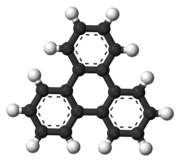Triphenylene is an organic compound with the formula (C6H4)3. A flat polycyclic aromatic hydrocarbon (PAH), it consists of four fused benzene rings. Triphenylene has delocalized 18-π-electron systems based on a planar structure, corresponding to the symmetry group D3h. It is a white or colorless solid.

| |

| |

| |
| Names | |
|---|---|
| Preferred IUPAC name
Triphenylene[1] | |
| Other names
Benzo[l]phenanthrene
9,10-Benzophenanthrene 1,2,3,4-Dibenzonaphthalene Isochrysene | |
| Identifiers | |
3D model (JSmol)
|
|
| ChEBI | |
| ChEMBL | |
| ChemSpider | |
| ECHA InfoCard | 100.005.385 |
| EC Number |
|
| KEGG | |
| MeSH | C009590 |
PubChem CID
|
|
| UNII | |
CompTox Dashboard (EPA)
|
|
| |
| |
| Properties | |
| C18H12 | |
| Molar mass | 228.294 g·mol−1 |
| Appearance | white |
| Density | 1.308 g/cm3[2] |
| Melting point | 198 °C; 388 °F; 471 K |
| Boiling point | 438 °C; 820 °F; 711 K |
| -156.6·10−6 cm3/mol | |
Except where otherwise noted, data are given for materials in their standard state (at 25 °C [77 °F], 100 kPa).
| |
Preparation
editTriphenylene can be isolated from coal tar. It can also be synthesized in various ways. One method is trimerization of benzyne.[3] Another method involves trapping benzyne with a biphenyl derivative.[4]
Properties
editTriphenylene is more resonance stable than its isomers chrysene, benz[a]anthracene, benzo[c]phenanthrene, and tetracene. For this reason triphenylene resists hydrogenation.[5]
As a disc-shaped, planar molecule, triphenylene has attracted attention as the core of discotic mesogen in liquid crystalline materials.[6]
References
edit- ^ International Union of Pure and Applied Chemistry (2014). Nomenclature of Organic Chemistry: IUPAC Recommendations and Preferred Names 2013. The Royal Society of Chemistry. p. 209. doi:10.1039/9781849733069. ISBN 978-0-85404-182-4.
- ^ Ahmed, F. R.; Trotter, J. (1963). "The crystal structure of triphenylene". Acta Crystallographica. 16 (6): 503–508. Bibcode:1963AcCry..16..503A. doi:10.1107/S0365110X63001365.
- ^ Heaney, H.; Millar, I. T. (1960). "Triphenylene". Organic Syntheses. 40: 105. doi:10.15227/orgsyn.040.0105.
- ^ Katie A. Spence, Milauni M. Mehta, Neil K. Garg (2022). "Synthesis of Triphenylene via the Palladium–Catalyzed Annulation of Benzyne". Organic Syntheses. 99: 174–189. doi:10.15227/orgsyn.099.0174. S2CID 250383238.
{{cite journal}}: CS1 maint: multiple names: authors list (link) - ^ Kofman, V.; Sarre, P.J.; Hibbins, R.E.; ten Kate, I.L.; Linnartz, H. (2017). "Laboratory spectroscopy and astronomical significance of the fully-benzenoid PAH triphenylene and its cation". Molecular Astrophysics. 7: 19–26. Bibcode:2017MolAs...7...19K. doi:10.1016/j.molap.2017.04.002. hdl:1887/58655. S2CID 67834616.
- ^ Janietz, Dietmar (2001), "Liquid Crystals at Interfaces", Handbook of Surfaces and Interfaces of Materials, Elsevier, pp. 436–437, doi:10.1016/b978-012513910-6/50014-1, ISBN 978-0-12-513910-6, retrieved 2020-08-23
External links
edit- Polycyclic Aromatic Hydrocarbon Structure Index Archived 2008-02-15 at the Wayback Machine